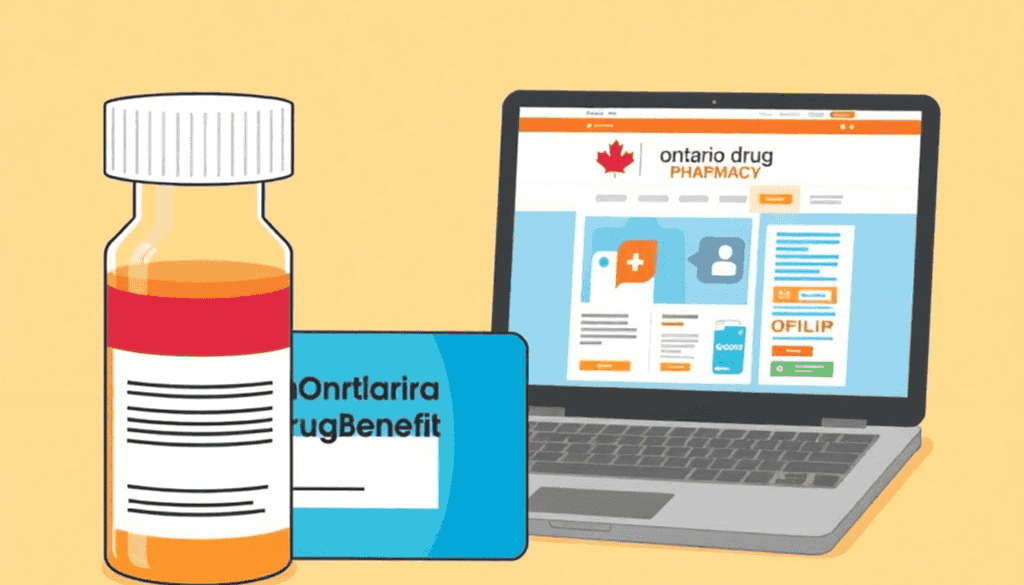Navigating Insurance Coverage for Prescription Medications in Ontario
Navigating insurance coverage for prescription medications in Ontario can be challenging. Prescription medication coverage is primarily provided through public programs designed to support diverse population groups. Two key programs stand out: the Ontario Drug Benefit (ODB) program and the Trillium Drug Program (TDP).
Understanding how these programs work is essential if you want to manage your health expenses effectively. Insurance coverage for prescriptions varies depending on factors such as age, income, and specific health conditions. Without clear knowledge of eligibility criteria, covered drugs, and cost-sharing models, you might miss out on valuable benefits or pay more than necessary.
Key points to keep in mind:
- Prescription drug coverage in Ontario is accessible through government-supported programs tailored to different needs.
- Coverage includes thousands of medications, from common generics to specialized biologics.
- Cost-sharing mechanisms like deductibles and co-payments depend on your personal circumstances.
This article will explore the Ontario Drug Benefit (ODB) program and the Trillium Drug Program (TDP) in detail. You’ll learn who qualifies, what drugs are covered, how costs are shared, and special provisions that may apply. Equipped with this knowledge, you can navigate insurance coverage for your prescription medications in Ontario with confidence.
While understanding these programs is crucial, it’s also important to know where to get your prescriptions filled. For instance, MisterPharmacist, a well-known online pharmacy in Toronto, offers fast prescription delivery services which can be a convenient option.
Moreover, some health conditions like syphilis, which is reportedly making a comeback, or bladder infections that require immediate attention and management. It’s essential to understand the symptoms and treatments related to these conditions for effective health management.
Lastly, while navigating through these health challenges and understanding insurance coverage for prescription medications, having access to reliable online pharmacy services like those provided by MisterPharmacist can significantly ease the process.
1. Ontario Drug Benefit (ODB) Program
The Ontario Drug Benefit (ODB) Program is a key program that provides prescription drug coverage to many residents of Ontario. By knowing who qualifies for the program and what medications are included, you can make better choices about your healthcare.
Who is Covered Under ODB?
The ODB Program has specific criteria that determine who is eligible for coverage:
- Residents aged 65 years or older.
- Individuals living in long-term care homes, residential homes, or receiving professional home and community care services.
- Persons enrolled in the Trillium Drug Program (TDP).
- Individuals receiving social assistance benefits such as Ontario Works or the Ontario Disability Support Program.
This broad eligibility ensures that vulnerable populations, seniors, and those with particular healthcare needs can access important medications.
Types of Prescription Drugs Covered
The ODB formulary includes approximately 5,000 prescription drugs covering a variety of treatment needs. Categories include:
- Allergy shots
- Epinephrine injectable products
- Diabetes monitoring and testing supplies
- Selected over-the-counter drugs prescribed under certain conditions
- Nutrition products prescribed by healthcare professionals
- HIV/AIDS treatment medications
- Palliative care drugs
- Smoking cessation aids
This comprehensive list supports treatment for chronic illnesses, acute conditions, and preventive health measures.
Coverage for Generic vs. Brand-name Drugs
The ODB primarily covers generic medications as the standard option due to their cost-effectiveness. Brand-name drugs may be covered when:
- The generic equivalent causes adverse reactions.
- The generic form is not available or appropriate.
Your healthcare provider can request coverage exceptions based on clinical necessity, ensuring you receive the most suitable medication.
Cost-Sharing Model for Seniors and Specific Groups
The program uses a cost-sharing approach that varies by individual circumstances:
- Seniors generally pay a deductible plus a co-payment for each prescription. The amounts are determined by income level and marital status.
- Certain groups such as long-term care residents or individuals receiving professional home/community care benefit from automatic coverage with minimal or no co-payments and no deductible.
Understanding these cost-sharing elements helps you anticipate out-of-pocket expenses while accessing necessary medications through the ODB Program.
Additional Considerations for Medication Use
While the ODB program provides extensive coverage, it’s crucial to be aware of certain aspects related to medication use. For instance, if you’re dealing with chronic conditions that require long-term medication, it’s important to understand the risks associated with such treatments. Are you taking too many drugs? This article outlines key signs of overmedication and offers guidance on regaining control of your health.
Moreover, some medications may lead to side effects like heartburn. If that’s the case, you might find useful insights in this ultimate guide to beating heartburn naturally, which provides natural remedies and lifestyle changes for relief.
In addition, understanding how to maximize nutrient absorption from prescribed dietary supplements can significantly enhance their effectiveness. For example, if you’re advised to take zinc supplements, this guide on taking zinc for maximum absorption could be beneficial. It offers insights into optimal timing
2. Trillium Drug Program (TDP)
The Trillium Drug Program (TDP) is designed specifically to assist Ontario residents facing high drug costs relative to their income. It acts as a safety net for people who do not qualify for full coverage under the Ontario Drug Benefit (ODB) program but still struggle with prescription expenses that can be financially burdensome.
Purpose of TDP
The main goals of the TDP are:
- Helps individuals and families whose prescription drug costs exceed approximately 4% of their after-tax household income.
- Provides financial relief by covering a substantial portion of eligible drug costs once a deductible is met.
- Supports people without comprehensive private insurance or those who have partial coverage that leaves them with significant out-of-pocket expenses.
Qualifications for TDP Coverage
Eligibility depends on:
- Your household’s net income and the total amount spent on prescription drugs.
- Being an Ontario resident who does not qualify fully for ODB or other public drug plans.
- Participation requires annual application and renewal, allowing the program to adjust based on changes in income or medication needs.
- Applications are made at the household level, meaning all members’ incomes and drug costs are considered collectively.
Additional Drugs Covered Under Exceptional Access Program
The TDP includes access to around 5,000 drugs listed on the ODB formulary. Beyond this, it offers coverage through the Exceptional Access Program, which provides:
- Access to roughly 1,000 additional medications not generally included in ODB coverage.
- Approval for these drugs is based on specific medical needs and evidence supporting their use when standard options are unsuitable or ineffective.
- This flexibility ensures patients receive appropriate treatments without facing prohibitive costs.
Participants pay a deductible calculated from their income, followed by a small co-payment fee per prescription. This cost-sharing model balances affordability with program sustainability, helping those with significant medication expenses avoid financial hardship.
Understanding the scope of TDP helps you evaluate if this program can reduce your prescription drug costs effectively. The focus on high drug cost relief and expanded drug lists through Exceptional Access makes it a vital option for many Ontarians managing chronic illnesses or complex medication regimens.
In addition to financial assistance, it’s important to note that understanding how to navigate and utilize these programs effectively can significantly impact your overall healthcare experience. For instance, utilizing resources such as testing could provide valuable insights into optimizing your healthcare journey.
3. Special Provisions and Transition Policies
The inclusion of biologic drugs and biosimilars within the Ontario Drug Benefit (ODB) and Trillium Drug Program (TDP) coverage reflects a response to advancing pharmaceutical therapies. These drugs are often critical for treating complex conditions such as autoimmune diseases and certain cancers. Both programs recognize the importance of access to these medications, which tend to be more expensive than traditional drugs.
Key points about biologic drugs and biosimilars in ODB and TDP:
- Coverage extends to select biologics listed on the formulary, ensuring patients can access these advanced treatments.
- Biosimilars are included as cost-effective alternatives, supporting sustainable drug benefit plans.
- Prescribing physicians must adhere to specific criteria outlined by the programs for approval.
Transition policies play a vital role when switching between biologic drugs and their biosimilar counterparts. These policies aim to maintain therapeutic continuity while managing costs and addressing patient safety concerns.
Essential features of transition policies include:
- Medical supervision: Switching must occur under healthcare provider guidance to monitor efficacy and adverse effects.
- Notification requirements: Patients may need formal approval or documentation supporting the medication change.
- Exceptions: Patients with adverse reactions or lack of efficacy on one product may remain on their current medication without forced switching.
Navigating insurance coverage for prescription medications in Ontario requires understanding these special provisions. Being aware of biologic drug availability and transition rules helps you anticipate potential changes in your medication plans without unexpected interruptions or financial burdens.
It’s also important to note that in certain situations, such as when a child vomits after taking medication, parents might need to understand redosing guidelines. This knowledge can be crucial in ensuring that the child receives the necessary dosage after such incidents, especially when dealing with biologic drugs which may have specific dosing requirements.
4. Prescription Refills, Travel Considerations, and Additional Support Programs
Following the timing rules for prescription refills is crucial to keep your coverage under Ontario’s public drug programs. Pharmacies usually process refills only after a certain amount of the medication has been used. This practice helps prevent early refills that could disrupt insurance coverage. It’s especially important for medications classified as controlled substances, which have stricter regulations to prevent misuse and ensure patient safety.
Traveling within Ontario: What you need to know about your prescriptions
When traveling within Ontario, it’s important to plan ahead when it comes to your prescription coverage:
- You can transfer prescriptions between pharmacies across the province.
- In certain situations, larger quantities of medication may be dispensed once a year to accommodate your travel needs.
- Prescriptions filled outside Ontario are not covered by ODB or TDP, so it’s essential to secure enough medication before you leave.
Additional restrictions for controlled substances during travel
Controlled substances have extra restrictions during travel because they have the potential for abuse. To avoid any interruptions in your medication supply, make sure to carry proper documentation and check the policies of pharmacies in the area you’re visiting.
Devices not covered under the Ontario Drug Benefit program
Devices like syringes and glucometers are not included in the coverage provided by the Ontario Drug Benefit program, even though they are crucial for managing chronic conditions such as diabetes. However, there are various provincial support programs and community health organizations that offer assistance in obtaining these devices at a lower cost or even free of charge. For instance, the newly introduced Universal Access to Diabetes Medications and Diabetes Device Fund aims to provide support for individuals requiring diabetes-related medications and devices. By checking your eligibility and understanding the application procedures for these programs, you can significantly reduce your out-of-pocket expenses.
By knowing these details about refills, travel plans, and device support options, you can confidently manage your prescription needs while making the most of Ontario’s drug coverage programs.
Conclusion
Understanding the eligibility criteria and benefits of public programs is crucial when dealing with prescription medication insurance coverage in Ontario.
The Ontario Drug Benefit (ODB) and Trillium Drug Program (TDP) are two key programs that offer vital assistance to many residents, helping to lower out-of-pocket expenses and ensuring access to necessary medications.
Here are some important steps you can take:
- Explore your eligibility for these programs carefully.
- Take advantage of cost-sharing models designed to ease financial burdens.
- Stay informed about special provisions that may apply to your medication needs, such as those related to ADHD medications which have specific coverage considerations.
By actively seeking out information and understanding your options, you can navigate the complexities of insurance coverage more effectively. This proactive approach has the potential to not only save you money but also improve your overall health outcomes.
FAQs (Frequently Asked Questions)
What is the Ontario Drug Benefit (ODB) program and who is eligible?
The Ontario Drug Benefit (ODB) program provides prescription drug coverage for eligible Ontario residents, including seniors and specific groups. It covers a range of prescription medications, with a cost-sharing model applied to seniors and other qualifying individuals.
How does the Trillium Drug Program (TDP) assist individuals with high drug costs in Ontario?
The Trillium Drug Program (TDP) helps Ontario residents manage high prescription drug costs by providing additional coverage beyond ODB. Eligibility depends on income and drug expenses, and it includes access to drugs through the Exceptional Access Program for medications not routinely covered.
Are biologic drugs and biosimilars covered under Ontario’s public drug programs?
Yes, both biologic drugs and biosimilars are included in the coverage provided by the ODB and TDP programs. There are specific transition policies in place to guide patients when switching between these medications to ensure continuity of care.
What should patients know about prescription refills and travel coverage under Ontario’s drug programs?
Patients must adhere to timing rules for prescription refills to maintain coverage. For controlled substances, there are special considerations when traveling outside Ontario. Additionally, some support programs exist for devices like syringes and glucometers that may not be covered under ODB.
What types of medications are covered under the ODB program regarding generic versus brand-name drugs?
The ODB program generally covers both generic and brand-name prescription drugs; however, there may be differences in coverage or cost-sharing depending on the medication type. Understanding these distinctions can help beneficiaries manage their out-of-pocket expenses effectively.
How can Ontarians navigate insurance coverage effectively for their prescription medications?
Navigating insurance coverage involves understanding eligibility criteria for public programs like ODB and TDP, knowing which medications are covered, being aware of special provisions such as biologics coverage, following refill timing rules, and exploring additional support programs. Staying informed enables Ontarians to maximize their benefits and minimize costs.



